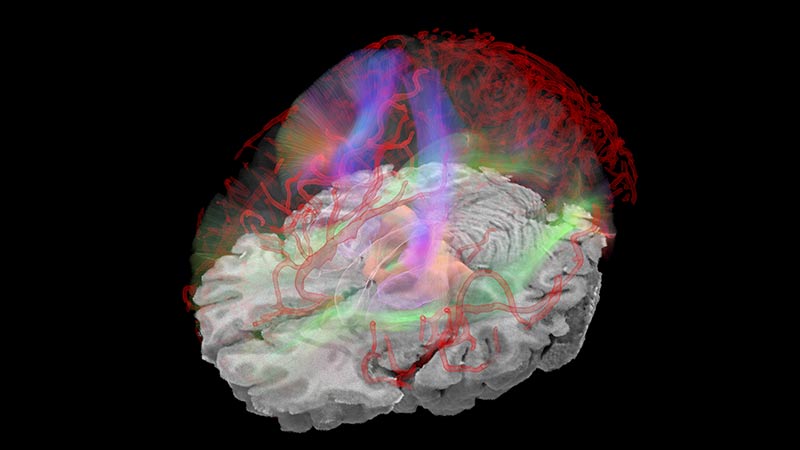By Sidney Taiko Sheehan

Diffusion tensor imaging (DTI) tracts and cerebral blood vessels within the brain. DTI is an MRI‑based neuroimaging technique that makes it possible to estimate white matter tracts of the brain.
Photo credit: USC Stevens INI
The Keck School of Medicine of USC’s Mark and Mary Stevens Neuroimaging and Informatics Institute (Stevens INI) is one of five institutions partnering in a five-year, $149 million grant from the National Institute on Aging (NIA) to address health disparities in Alzheimer’s disease research. This grant will continue to fund the Health and Aging Brain Study – Health Disparities (HABS-HD), the most comprehensive study of Alzheimer’s disease (AD) among diverse communities ever conducted. Lead researchers on this project include Sid O-Bryant, PhD, and Leigh Johnson, PhD, of the University of North Texas Health Science Center; Kristine Yaffe, MD, of the UCSF Weill Institute for Neurosciences; Robert Rissman, PhD of the University of California, San Diego; and Arthur W. Toga, PhD, of USC.
One of the most significant challenges in AD research is identifying biomarkers that determine who is at risk for developing the disease. Historically, researchers have focused on three biomarkers: the protein amyloid, which forms clumps in the brain; the protein tau, which forms neurofibrillary tangles; and brain atrophy, which is visible with CT or MRI scans. In 2018, a group of neuroscience experts created a framework known as the AT(N) framework—A for amyloid, T for tau, and (N) for neurodegeneration or atrophy, with the hope of advancing clinical trials. The work of the AT(N) framework was crucial for the development of the first amyloid-lowering drug (aducanumab), which now has received FDA clearance.
HABS-HD aims to take the AT(N) framework to a new level by addressing a key complication in the initial framework: lack of diversity. Nearly all data supporting the framework itself, as well as clinical trials, comes from research among non-Hispanic white individuals. The U.S. Census Bureau projects that by 2060 the U.S. will become largely “non-white” with 15% of the population being African American and 27.5% being Hispanic. Therefore, there is an urgent need to understand the relevance of the AT(N) framework, and associated biomarker-based therapeutics, for 43% of the U.S. population.
“Research has revealed that Hispanic and African American populations experience a significantly greater risk of developing mild cognitive impairment and Alzheimer’s disease than non-Hispanic whites,” says Stevens INI Director Arthur W. Toga, PhD, who serves as the neuroimaging and informatics lead for the HABS-HD study. “HABS-HD is the first of its kind — a large-scale study using the AT(N) framework with a cohort that is more representative of the ethnic diversity we live in.”
The HABS-HD study has now enrolled nearly 1,000 Mexican Americans and 1,000 non-Hispanic whites, with enrollment for an additional 1,000 African Americans in process. All participants undergo procedures including an interview, functional exam, blood draw, memory and cognition testing, brain MRI and clinical laboratory blood work. Participants are seen at 24 to 30 month intervals at the Institute for Translational Research in Fort Worth, Texas. The research team studies the biology of disease within the context of social, environmental and behavioral factors. To be reflective of the diverse population, research is needed to understand this devastating disease among everyone, given that AD and other brain diseases appear to impact communities differently.
As the HABS-HD neuroimaging and informatics leader, along with co-lead and Stevens INI member Meredith Braskie, PhD, Toga oversees neuroimaging acquisition, storage, and maintenance through the Laboratory of Neuro Imaging (LONI), housed by the Stevens INI. LONI uses cutting-edge imaging and informatics to collect and analyze images of the brain. Toga also runs the informatics for the Alzheimer’s Disease Neuroimaging Initiative, the largest and longest-running biomarker discovery effort in Alzheimer’s disease research, as well as the Global Alzheimer’s Association Interactive Network, which aggregates the largest collection of Alzheimer’s data in the world. Toga and his team are well poised to make great strides in this project by managing data and making datasets available to qualified researchers in compliance with NIH data sharing policies for the benefit of the greater scientific community.
“Our considerable experience with big data and studies that address health disparities will enable us to quickly meet the challenges associated with the ambitious goals of this project,” said Toga, also a Provost Professor of Ophthalmology, Neurology, Psychiatry and the Behavioral Sciences, Radiology, and Engineering and the Ghada Irani Chair in Neuroscience at the Keck School. “The HABS-HD study is emblematic of our goals here at the Stevens INI to be highly collaborative and to use our expertise to make a difference in Alzheimer’s and related dementias research that does not exclude the ethnic groups so profoundly impacted by these diseases.”
You can receive more information about accessing HABS-HD data here.